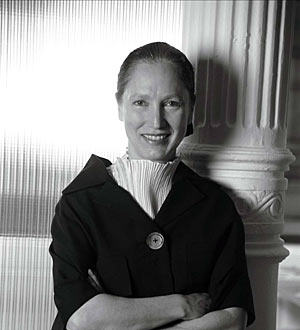Margaret Helfand, FAIA, died June 20 at the age of 59. Her death was due to colon cancer. Since she opened her office in 1981, Helfand had created a body of work distinguished for its clean, Modernist vocabulary and skillful use of natural materials, combined with a quiet and subtle inventiveness. Her commitment to the craft of construction, the exploration of materials of varying textures, as well as her attention to details, set Helfand apart from a number of her colleagues.

Except for a brief partnership, Helfand practiced on her own and gradually broke through gender typecasting. Female architects often find themselves relegated to designing houses and interiors for their entire careers, but Helfand was able to start small and go on to execute the large-scale institutional and commercial work that is more frequently the preserve of her male counterparts.
Helfand’s best known projects include such major school buildings as Kohlberg Hall at Swarthmore College, in Swarthmore, Pennsylvania (in association with Eckstut Ehrenkrantz and Kuhn, RECORD, February 1997, page 70), and Unified Science Center, also at Swarthmore College (in collaboration with Einhorn Yaffee Prescott, RECORD December 2004, page 198).
At Kohlberg Hall, Helfand’s combination of ashlar and cobweb gneiss with granite fit the Modernist building supremely well within the context of stone and slate collegiate-Gothic structures at the wooded campus. In the Unified Science Center, Helfand designed laboratory and social gathering spaces again using local stone in a manner that invokes Alvar Aalto’s and Eliel Saarinen’s architecture.
In her design for Automated Trading Desk, in Mount Pleasant, South Carolina (with McKellar & Associates, RECORD, June, 2003, page 156), Helfand created a headquarters acclaimed for the way individual work places are integrated with the landscape. In addition to creating large-scale projects, Helfand also continued designing interiors, including the offices of Time Out magazine at two successive locations in New York City and one in Chicago. At the time of her death, the first phase of Helfand’s renovations for educational facilities at Friends Seminary, New York, was nearing completion.
Throughout her career, Helfand remained committed to serving the architectural community. Following 9/11, during her term as the president of the New York chapter of the American Institute of Architects, she was co-chair of New York New Visions, a coalition of numerous organizations, including the AIA, which proposed to government agencies urban design and planning guidelines for rebuilding the World Trade Center site.
“Helfand wanted to ensure the public was involved in the planning procedures,” says Frederic Bell, FAIA, executive director of the New York chapter of the American Institute of Architects. “She was very giving of herself and her time to the architectural community, which is often so difficult to do for a sole practitioner. She managed to do that and turn out an exemplary body of architectural work.”
From 1999 to 2003, Helfand acted as the chair for the Premises Committee for the Center for Architecture, a building being designed especially for the New York A.I.A. on La Guardia Place. While involved in this ad hoc task force overseeing the Center’s construction, Helfand was also a prodigious fundraiser for the chapter. In 2006, she designed the installation for the exhibition “The Fashion of Architecture, Constructing the Architecture of Fashion” at the Center.
Helfand won a Rome Prize to work in residence at the American Academy in Rome from 2002-2003, one of numerous awards recognizing her accomplishments. She was named a Fellow of the AIA in 1998.
Born in Pasadena in 1947, Helfand attended Swarthmore College from 1965-68, and completed her undergraduate education at the University of California Berkeley in 1969. A year later, she enrolled at the Architectural Association School, in London, where she also studied at the International Institute of Design. During this period, she and a group of friends bought a 90-foot-long, three-masted schooner, rebuilt it, and sailed to Spain and the Caribbean.
Helfand returned to Berkeley, where she earned an M.Arch. in 1973, and then sailed another year from Costa Rica across the South Pacific. Her experience on the boat, as Paola Antonelli writes in the introduction to Margaret Helfand Architects: Essential Architecture, gave her experience in carpentry and cabinet making. It also instilled a love of vernacular architecture. In addition to sailing, Helfand considered her interest in modern dance, as a performer and spectator, to be instrumental in the understanding of the movement of the body through architectural space.
During the early 1970s, Helfand worked for Backen Arrigoni & Ross, Hank Bruce Architects, and Skidmore Owings & Merrill in San Francisco, before coming to New York City in 1975, where she joined Marcel Breuer Associates. She remained there until she opened her own office. In 2005, she opened a special joint firm with Tanner and Hecht, in San Francisco, to pursue institutional work in California.
Helfand is survived by her husband of 28 years, Jon Turner, and a sister, Judy Helfand, of Kenwood, California.



Post a comment to this article
Report Abusive Comment